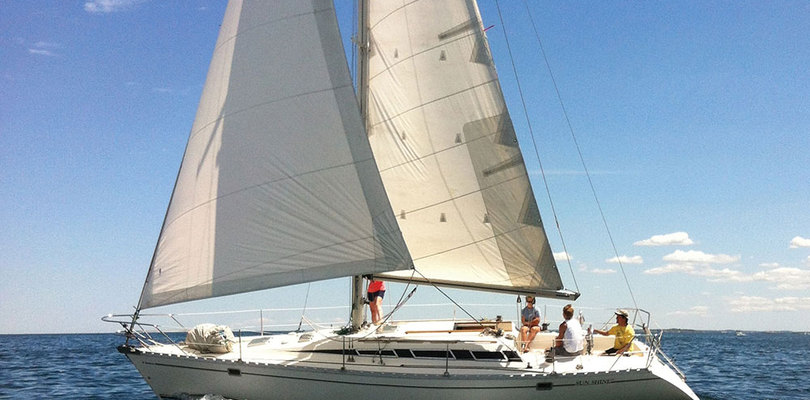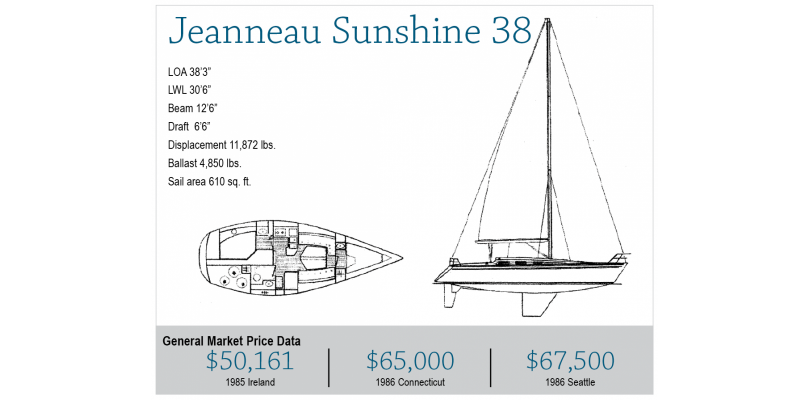Jeanneau Sunshine 38
A blend of speed and comfort still stacks up on one of the first performance cruisers
When Tony Castro designed the Jeanneau Sunshine 38 in the early 1980s, many other naval architects had not yet caught up with the notion that sailors might want a comfortable cruising yacht that was also capable of attaining speeds typically achieved only by race boats.
Upon leaving Ron Holland’s design team in 1980, Castro found himself on the cutting edge of a movement toward performance cruisers. His popular Jeanneau Sunshine 36 was launched in 1982 and the Sunshine 38 was an intelligent evolution in 1983.
A masthead-rigged sloop with fin keel and spade rudder, the Sunshine 38 outshined its 36-foot little sister with the addition of a scoop transom that increased waterline length, resulting in more speed that caught the attention of performance-driven sailors.
The sugar-scoop transom is not a walk-through. However, it allows for installation of an optional swim platform on some models, a feature that attracts families of recreational sailors and makes the boat more user-friendly when chartering in the Caribbean. The scoop provides a welcome dinghy dock, gives swimmers a convenient place to climb aboard and doubles as an outdoor shower location.
With a fast hull and strong rig, the lightweight Sunshine 38 is capable of efficiently capturing a gentle breeze or taking on a gusty blow. Just as Castro planned, it’s the perfect combination of speed and comfort.

First impressions
At first glance, the Jeanneau Sunshine 38 doesn’t look like a cruising yacht. Four beefy winches, aluminum toerail track, adjustable backstay and a destroyer wheel give the impression this boat is ready for the start line. Viewed from abeam, it sports a racy profile, but its ample girth is quickly apparent from astern. It’s clearly both a cruiser and a racer. Traditionalists pleased by the beauty of varnished wood are likely to notice its absence on deck, but there’s plenty of exotic teak paneling below where the warm glow fosters a feeling of cozy comfort.
Construction
The Sunshine 38 hull is fiberglass laminate, the deck a sandwich of fiberglass layers with balsa core. Hull-to-deck joints are tabbed, taped and sealed because delamination can occur if water is allowed to seep into the balsa core. The mast is deck-stepped and stabilized by a compression post that extends downward through the saloon dinette table until it rests on the keel. The iron keel is attached to the hull with stainless bolts.
What to look for
There’s no getting around the fact that just about every Sunshine 38 built is now more than 30 years old. Owners report having to replace standing rigging and undersized bolts holding stanchions to the deck. Aging ports and hatches may still be watertight but the glass is likely clouded and scratched. According to owner Josh Antrim of Nahant, Massachusetts, the stainless steel stanchions on his 1985 sloop have stood the test of time, but the undersized fasteners cause deck crazing when pressure is applied to the post. Installing larger diameter bolts and under-deck backing plates may be the solution, he said, adding that similar crazing and undersized fasteners can be found at the bow and stern pulpits. Access to these pulpit fasteners from below deck is relatively easy.
Buyers should inspect the iron fin keel for rust. It may need a special paint-on barrier coating and fairing. Examine the thin teak strips screwed to the cockpit sole. While aesthetically pleasing, these screws may loosen over time and allow water to get beneath the fiberglass sole where it can cause damage.

On deck
The Sunshine 38 deck layout is relatively orderly. The cockpit accommodates six but can be tight. The teak cockpit table has hinged wings that allow it to fold open. A pedestal supports the binnacle compass and destroyer wheel. A pair of two-speed, self-tailing winches control the jib sheets. Two smaller winches mounted on the cabin top handle the halyards.
The traveler is bolted to the bridgedeck, which makes it convenient but also takes up valuable cockpit space. Some owners have relocated the traveler to the coachroof. Control lines lead back to the cockpit so that the boat can be singlehanded.
Owner Eric Treu of Brandford, Connecticut, is among those sailors who prefer a tiller, so he swapped out the wheel.
“You have a much better feel for the boat with a tiller. Besides, it works fine with the autopilot,” he said.
The boat has no electric windlass, a feature many owners have added. The anchor is stowed in a deck locker that drains into the bilge. Adding a windlass and enlarging the locker would allow use of all chain instead of a short length coupled with rope.
The sloop’s masthead rig includes a roller furling jib.
Down below
Belowdecks, the Sunshine 38 has a big feel. It’s roomy, due in part to the boat’s high freeboard. Treu, who has owned a 1986 model for about 15 years, described the boat as well-appointed. According to Treu, compared to boats of similar size and age built by companies like Pearson and Ericson, the Jeanneau Sunshine 38 is luxurious.
“The whole interior is different. It’s not too serious and kind of plush,” he said. “The French understood that boats must be designed to be both fast and comfortable.”
Treu sails the owner’s model, which features a single, spacious aft stateroom with private sink rather than two smaller aft cabins. The boat has one head. The saloon features a teak pedestal table that seats six and breaks down into a double berth.
“That is the most comfortable place to sleep on the boat. It’s perfect for the kids and even the dog,” Treu said.
The standard model has three cabins (two doubles and one in the V-berth), as well as two double bunks in the saloon, which allows the boat to sleep 10. Headroom in the saloon is 6 feet. Two settee benches combine to form double bunks on both port and starboard.
The saloon is paneled in teak. The port-side galley is equipped with a propane-gas stove and oven, refrigeration, water heater and double-basin stainless steel sink. The boat carries two 45-gallon fresh water tanks and has a separate nav station.
Engine
The yacht was originally equipped with a single, reliable 30-horsepower Yanmar 3GM30 diesel engine. The engine can be accessed for service by raising the companionway steps. A panel on the port side of the aft cabin also provides access. Several owners complained it was short on horsepower, especially in choppy seas. The Sunshine 38 has a single 22-gallon fuel tank.
Underway
This sloop has plenty of get up and go. This 38-footer, when fitted with a battened mainsail in new condition, can easily handle 20 knots of breeze without a reef, Treu said.
“Just crank on the vang and backstay and watch her go,” he said.
Even for sailors with moderate skill, the Sunshine 38 is easy to handle. The boat excels in light winds. Her handling characteristics include the ability to stay on track with little effort once the helm is balanced.
“It’s nice to spin on a dime,” said Antrim, who previously owned a Tartan 34. “It’s pretty responsive compared to my last boat.” He praised the Jeanneau’s sail area-to-displacement ratio and its ability to sail in light air. “Our average speed is 7-8 knots. That’s not what you’d get with a cruising boat.”
Conclusion
The Jeanneau Sunshine 38 stands out as an early performance cruiser that should satisfy recreational cruisers, weekend racers and even those sailors who want to venture offshore. In Treu’s words, “The best things about this boat are speed and comfort.”
SAILING’s Value Guide
(5-sailboat rating system)
PRICE: A used Jeanneau Sunshine 38 can range from approximately $50,000 to $67,500, although some recent sales have been reported at lower price points for boats needing extensive upgrades. (3 sailboats)
DESIGN QUALITY: Designed by Tony Castro, this 38-foot masthead sloop was meant to meet the demands of sailors who like to race as well as cruise. The result was a balanced performance cruiser with fin keel and spade rudder. (3.5 sailboats)
CONSTRUCTION QUALITY: The Sunshine 38 was built in France from 1983 to 1987 while Jeanneau was owned by Bangor Punta, a U.S.-based corporation. Other Jeanneau models of the day, such as the Sun Fizz 39 (sold in the U.S. as the O’Day 39), were built under license in the U.S. Ownership of Jeanneau eventually reverted to France and was eventually bought by Beneteau in 1995. (3 sailboats)
USER-FRIENDLINESS: Current and previous owners seem to agree the Jeanneau Sunshine 38 is both comfortable and fast, with a cockpit roomy enough for six unless the traveler has been bolted to the bridgedeck. With lines led back to the cockpit, the yacht can be singlehanded. (3 sailboats)
SAFETY: The 38 has stainless steel stanchions and double, heavy-duty lifelines for safety, as well as a bow pulpit and, on some models, a split stern pulpit with entry gate and swim platform. The cockpit is designed to reduce flooding from waves. (3 sailboats)
TYPICAL CONDITION: These yachts range in condition. Generally those used in charter service tend to be well used, while boats sailed privately are often in better shape. Potential buyers should keep in mind these boats are nearly three decades old and will have age-related problems. (3 sailboats)
REFITTING: Common upgrades include new standing rigging, lifelines, running rigging, portals and hatch covers. A windlass was not stock on the Sunshine 38 but some owners have chosen to install one along with a modified anchor and chain locker on deck. (3 sailboats)
SUPPORT: Several Jeanneau owner support groups and blogs are accessible online but none are specific to the Sunshine 38. These include www.jeanneau-owners.com and general information at www.jeanneauamerica.com. (3 sailboats)
AVAILABILITY: Many Jeanneau sloops of 1980s vintage are for sale in the United State,s including the Sunshine 36, but the Sunshine 38 is more often found on the market in Europe. (2 sailboats)
INVESTMENT AND RESALE: The yacht has a stable resale value. (3.5 sailboats)

Comments